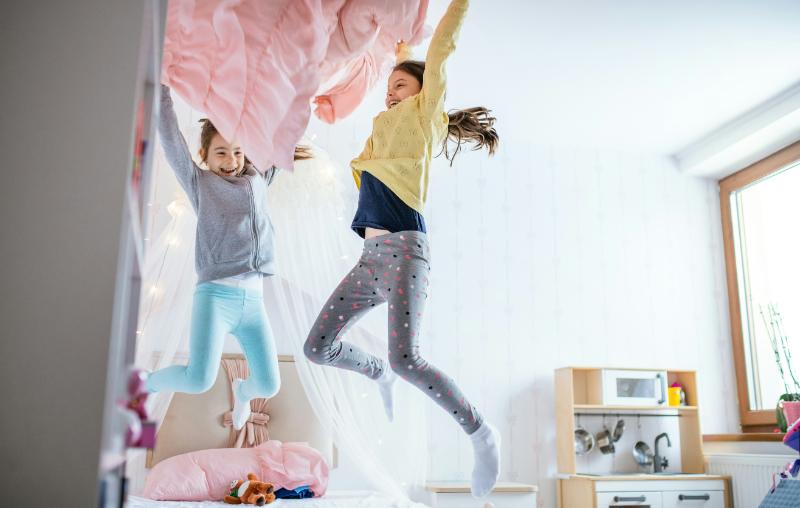When we think about home renovation, there can be certain jobs that seem more straightforward than others. A great example is a child’s bedroom because it potentially requires a lick of paint, some cute bedding, and a new carpet, and you’re good to go, right? But if we really look into what makes a great child’s bedroom, it’s not just about what we think they should have, but also what they want. It needs to be somewhere they can retreat to and enjoy, but ideally, it will also work with the rest of the house.

It’s a tough one because when our children reach a certain age we essentially need them to spend more time in their room so we can get on with other house duties, and this is why a great bedroom is not just somewhere for them to sleep, but is a sanctuary, playing space, and a source of inspiration for them, not to mention a place where they can actually do homework. This is a big ask, so let’s have a look at what it really takes to create a great child’s bedroom.
Making It a Personal Space
The last thing we want to do is to give them a bare-boned space with colors that you think they want. It’s important to involve your child in the design process, and while your child may not necessarily know exactly what they want, it’s about teasing out the right information from them. Green may very well be their favorite color right now, and although you may have a child that changes their mind every couple of months, there’s certainly a balance to be had here where they can get what they want but you can also hedge your bets. Something like green wallpaper is an excellent example because you can put the wallpaper up, and then if they change their minds and time later you can make a few changes.
But of course, you also need to look at their favorite themes, interests, and hobbies and incorporate this into their space. Decals are an excellent example if you have a child who doesn’t necessarily know what they want or changes their mind constantly with regards to wall colors. Wall decals can represent the things they love, but it also means that you won’t need to make massive changes to their bedroom every few months. We should allow our children to express their personality, but this means asking them a lot of questions about the things that make them want to return to their bedroom every day.
Designate Different Zones
These days, there’s a lot more information out there about why a bedroom should purely be for sleeping and nothing more. Over time, as adults, we come to associate our bed with things other than sleeping, and this can contribute to feelings of exhaustion or insomnia. Of course, our children need a place where they can rest, but we have to put a lot of effort into creating a bedroom that has distinct areas. Our children will not have the luxury of making their bedroom a space just for sleeping but what we can do is define different activity areas.
You can create different zones so your child starts to associate different areas with different purposes. For example, if they like to relax in their room but you don’t want them to relax in bed in case they already have issues sleeping, a beanbag is an excellent addition. Place this in the corner or, if you have the finances, a small sofa, and this can become a cozy reading nook where they can unwind.
If they are at the age where they’re now doing homework, another corner can be a desk, or if space is a problem you can purchase a raised single bed that has room for a desk underneath. You can then also incorporate a play area with toys, games, and anything else they enjoy. When it comes to defining these zones, it’s about making sure you create a sense of visual separation. You can do this by placing furniture in specific ways, but also playing with the lighting. For example, for a space your child will be using for homework, it’s important to have an overhead lamp that is quite bright and allows them to focus on their work without getting distracted by toys and other things. The desk should be facing a wall rather than somewhere that’s giving them the luxury of distraction.
It can be particularly tough to get right, but it is so important for us to remember that when your child has a bedroom that serves multiple purposes, the art of separation will make a big difference.

Maximizing Storage
This is particularly important if they don’t have a huge amount of space. This is where something like multifunctional furniture such as beds with built-in drawers or storage cubbies can be very useful.
There’s other ways for you to store smaller items like toys, for example, storage containers or themed toy bins. As your child gets older, so will the volume of their belongings, and we should ensure there is ample storage space. One of the best solutions here is to have a bed that’s high enough so things can go underneath, but also be creative with how things are stored, for example, you could store items upwards if there’s not a huge amount of room.
Using Color Strategically
We’ve already spoken about how much control we should let our children have over design, but we need to remember that color is not just about how a space looks, but how it inspires and draws visual interest. You need your child’s bedroom to help them to relax, get inspired, do homework, and so forth.
Your child will have certain favorite colors that you may not think work well on the wall and this is why you should choose their favorite colors as accents, but also balance them with more neutral tones, this can create a far more aesthetically appealing look that can work with the rest of the house.
You can incorporate pops of their favorite color through things like the curtains and bedding, especially if you want the walls to be a certain color, but you should also look at playing with the right types of colors to make the room feel open or calming. We have to remember that if we’ve got a particularly anxious child who doesn’t want to go to sleep and is at that age where you are having battles at bedtime, opting for the least stimulating colors will make a big difference to everyone.
Prioritizing Comfort
Our children will go through so many developmental leaps as soon as they’re in their own room, all the way up to 16 and beyond. The bedroom should be a place that is theirs and if they don’t have a sense of privacy this can be partly our fault as parents, and we have to remember that if they don’t feel safe and secure in the place where they’re meant to relax and unwind, then this could cause a whole heap of anxieties that we need to address.
In terms of bedroom design, we can incorporate a number of things that promote relaxation, for example, simple things like adequate lighting and ventilation but also look at creating a warm welcoming atmosphere that suits them, such as soft and inviting bedding, and changing their pillows regularly. But we also need to remember that we actually have to give them the sense of privacy that they deserve.

It can be very easy to have an “open house,” where everybody is coming back and forth but the older children get the more privacy they will want and we have to respect this. Prioritizing their comfort is about appealing to their senses but also ensuring that they have everything they need so they will naturally want to retreat there. This could very well mean setting up their games consoles or a TV in their room, but you will need to be aware of what this does to your child and if it’s overstimulating in the long run.
Creating the right bedroom is not just about color and placement, but about so much more. A bedroom needs to be somewhere that we retreat to and relax, but it also needs to stimulate and inspire in equal measure. Your child’s bedroom is going to be their real home for a decade or more, and this is why you need to start thinking about all of these components as a priority.
